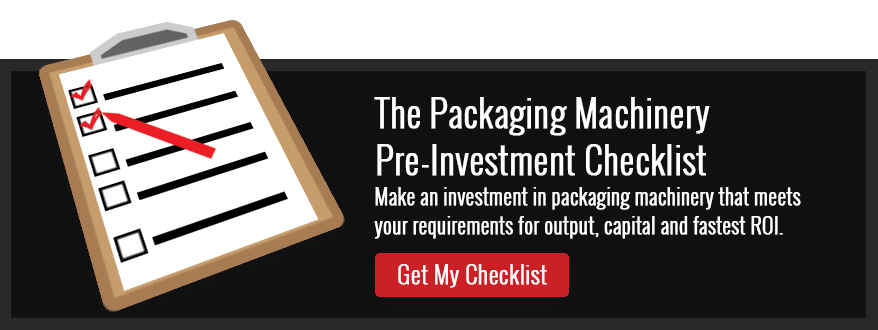How To Develop Your Ideal Packaging Strategy
Packaging Materials | Environment | The Business of Packaging | Investment | Packaging Design | Food Packaging | Packaging Psychology
If you want to achieve maximum efficiency with your production and packaging strategies, it’s never been enough to operate with a day-to-day, tactical mentality. This short-term mindset will only go as far as helping you accomplish daily tasks and meeting project goals. But in 2018 especially, it takes a much more proactive approach to realize long-term organizational success and achieve the efficiencies that have a lasting impact on your bottom line and growth.
If you run a packaging department – or any operational team – you need to assess how your functionality supports the goals of your larger organization. Developing a packaging strategy is a fundamental step toward aligning with high-level business goals and making the most of every dollar and minute you invest in packaging.
Buying packaging machinery? Use this checklist to determine if you’re making a sound purchase
Why a Packaging Strategy is Important
As an internal department, operating to support the goals and expectations of the larger organization, functioning without a strategy that aligns with management goals is a recipe for failure.
Effective organizations set goals and objectives that flow down from the top and affect the guidelines of your packaging department. You have to understand how your actions and operations impact your business’ overall success. For example, an organization that makes sustainability a top priority requires its packaging department to develop systems that consider the environmental impact of the packaging development process.
Developing a packaging strategy is not a simple or easy task. It must encompass several goals that your management team may set. Redesigning your packaging for marketing purposes is an important responsibility, but it is far from the only one. Sustainability, efficiency, and profitability are just some of the important focus areas of many product companies. But how do you create a strategy that incorporates many complex objectives?
The Basic Steps to Developing Your Packaging Strategy
The start of any strategic development is the discovery phase. You need to invest plenty of time into familiarizing yourself and team with your organization's general goals and mission. As previously mentioned, many companies have a very prominent sustainability mission and they expect the ideology to be carried out by the entire company. At this stage, it’s also important to understand individual stakeholders’ goals. Each department within your organization will interpret the goals differently. From complete understanding of such objectives comes alignment – determining what you will need to do to carry out the mission.
You then want to spend time learning as much as you can about the current and future state of your industry and how it’s operating. Industry analysis is an especially important step because it helps you plan for more than the present – The best strategy considers the future of your company and industry.
After you’ve gathered industry information, organizational goals and other motivators, you should have a complete and thorough understanding your organization's overarching position within your industry. Only then can you move forward to determine how each goal impacts the functions of your packaging department and operation, including:
- Safety
- The risks to the consumer and to the people on your plant floor will have a strong influence on your packaging objectives
- The risks to the consumer and to the people on your plant floor will have a strong influence on your packaging objectives
- Functionality
- The technology and design needed to meet objectives; e.g., maintaining and extending produce freshness throughout its shelf life
- Convenience
- The ease of opening, re-closing and disposing of packages
- Packaging Differentiation
- The degree to which your packaging must be differentiated from competitor packaging
- Promotion
- The degree to which your packaging is relied on to promote your product
- Brand Reinforcement
- The importance of brand recognition through packing, such as with shape or color
- Communication
- The messaging that your packaging must communicate to consumers
- Protection
- The packaging you go to market with needs to protect your product throughout the supply chain, maintaining presentation and longevity in the different environments it will be subjected to on its path to the consumer and beyond.
- Budget and Return
- Keeping budget in mind throughout each department involved in your product line is important! Understand the packaging material costs and total cost of production of each finished good, and the expected return from each campaign, promotion and initiative.
The way that each of these goals impacts how your packaging department operates will help you identify an underlying strategy. Systematically, you have corporate goals that stem from industry forces and shape your own departmental goals. And those goals shape your objectives with each packaging function. The figure below shows the highest level of this process:
The last step is developing your statement of goals. Much like the vision and mission statement concept, putting your goals on paper is a key step to making legitimate change. Your vision statement is the big picture of what you must achieve. Your mission statements are a general statements of how you will realize that vision.
Next comes the determination of the objectives that, when achieved, will indicate successfully meeting your overarching goals. These are the more detailed steps and activities that help you progress toward your goals. Your corporate strategy flows down throughout your organization, helping you design the tactics and day-to-day activities that will help your organization grow.
It’s easily to lose sight of the big picture when so many detailed objectives are wrapped up into company goals. That’s why documenting everything – even your key takeaways from the discovery phase – is so important. It’s easier to execute tactics that clearly help meet objectives that help achieve goals.
Creating a Packaging Strategy That Helps Build Your Brand
After you’ve put your overarching packaging strategy in place, you want to spend additional time thinking through how you can effectively build your company brand within those overall guidelines. After all, the design of your packaging goes a long way toward determining if your product makes it from the shelf and into the hands of the consumer.
No matter the product category – wine, perfume, apparel, laundry soap, toilet paper – successful packaging design is about depending on its ability to emotionally connect with the consumer. As much as advertising begins the “conversation” with consumers, 80% of purchase decisions are made at the shelf. Need more evidence of packaging’s importance? Your product presentation is the only form of marketing that 100% of your customers have seen – They’ve seen your packaging, picked up your product, and placed it into their shopping carts. How do you make sure you’ll grab shoppers’ attention and hold it?
The answer comes down to the shopability of your packaging – how well it will catch the attention of you target consumer and connect with them on an emotional level. Based on the essential design characteristics of shoppable packaging, your design should:
- Be simple and focused
- Have a clear brand messaging hierarchy
- Spotlight your product differentiators or new benefits/features
- Take advantage of color, shape, imagery and words
Strategic Packaging is Effective Packaging
Great results and lasting success are almost always the product of planning and strategy. Investing in research and communication throughout your organization will greatly increase the likelihood that you will succeed, whether your objective is operational efficiency, product shopability, or both.
Most importantly, your organization as a whole will make tremendous strides because your department and others used overarching goals to form your own objectives. And because you documented your strategy, you and your team were able to maintain focus on the details of your plan and execute it to perfection.
Planning to purchase packaging machinery in the next year? Learn which questions you must ask yourself before signing on the bottom line? Click below to download your copy of our comprehensive pre-investment checklist.
About David Roberge
I am grateful to be part of the outstanding Industrial Packaging team. I am able to hang out with some of the most knowledgeable folks in the packaging industry. I feel even luckier that I am able to share that knowledge with you. I love learning, hiking, and growing people and teams both personally and professionally, and helping companies grow better.




